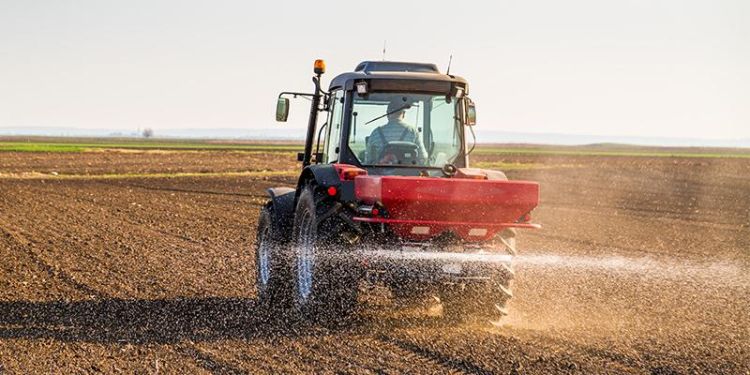Global food production poses an increasing climate threat

Rising nitrous oxide emissions are jeopardizing climate goals and the Paris Accord, according to a new international study.
The growing use of nitrogen fertilizers in the production of food worldwide is increasing concentrations of nitrous oxide in the atmosphere—a greenhouse gas 300 times more potent than carbon dioxide—which remains in the atmosphere longer than a human lifetime.
These findings, published today in Nature, are part of the most comprehensive assessment to date of all sources and sinks of the potent greenhouse gas nitrous oxide.
The study was produced by an international consortium of scientists from 48 research institutions in 14 countries under the umbrella of the Global Carbon Project and the International Nitrogen Initiative. The consortium included University of Leeds researchers Dr Chris Wilson and Professor Martyn Chipperfield.
The study points to an alarming trend affecting climate change: Nitrous oxide has risen 20 percent from pre-industrial levels and its growth has accelerated over recent decades due to emissions from various human activities.
The study also determined that the largest contributors to global nitrous oxide emissions come from East Asia, South Asia, Africa and South America.
Emissions from synthetic fertilizers dominate releases in China, India and the U.S., while emissions from the application of livestock manure as fertilizer dominates releases in Africa and South America, the study found. The highest growth rates in emissions are found in emerging economies, particularly Brazil, China and India, where crop production and livestock numbers have increased.
Demands on the global agricultural system are likely to continue to grow in the coming decades which could lead to increases in atmospheric greenhouse gases.
The co-authors agreed that the most surprising result of the study was the finding that current trends in nitrous oxide emissions are not compatible with pathways consistent to achieve the climate goals of the Paris Climate Agreement, or the Paris accord.
Signed by 195 nations, the Paris Climate Agreement aims to strengthen the global response to the threat of climate change by keeping a global temperature rise in the twenty-first century well below 2 degrees Celsius above pre-industrial levels, and to pursue efforts to limit the temperature rise even further, to 1.5 degrees Celsius.
However, the study also highlights existing opportunities to reduce nitrous oxide emissions.
Industrial and agricultural policies to reduce greenhouse gases and air pollution and to optimize fertilizer use efficiencies have proven to be effective in European countries. But further efforts are needed, in Europe as well as globally.
Study co-author Dr Wilson, from the School of Earth and Environment and National Centre for Earth Observation (NCEO) at Leeds said: “This study highlights the stark reality that global emissions of nitrous oxide are increasing on a trajectory that is strongly at odds with the targets set in the Paris Climate Agreement.
“However, we have also shown that mitigation strategies have been effective in some regions. This should serve as motivation for the world to go further and quickly adapt our agricultural processes to reduce our greenhouse gas emissions.”
Professor Chipperfield, also a member of the School of Earth and Environment and NCEO, said: “Demands on the global agricultural system are likely to continue to grow in the coming decades which could lead to increases in atmospheric greenhouse gases. This comprehensive research points the way to how we can mitigate this impact by suppressing the resulting increase in nitrous oxide emissions.”
The study drew results and estimates of nitrous oxide emissions from a comprehensive range of sources, including University of Leeds research. Dr Wilson and Professor Chipperfield used the TOMCAT inversion framework to determine nitrous oxide emissions during 1998-2016, based on atmospheric nitrous oxide observations from global networks and simulation of atmospheric transport and chemistry.
This estimate was combined with other estimates from inverse modelling and estimates from bottom-up methods such as direct measurement and process modelling.
Professor Hanqin Tian, director of the International Center for Climate and Global Change Research at Auburn University, USA co-led the study. He said: “The dominant driver of the increase in atmospheric nitrous oxide comes from agriculture, and the growing demand for food and feed for animals will further increase global nitrous oxide emissions.
“There is a conflict between the way we are feeding people and stabilizing the climate.”
Study co-leader Josep “Pep” Canadell, chief scientist in the Climate Science Center at the Australia-based Commonwealth Scientific and Industrial Research Organisation and executive director of the Global Carbon Project said: “This new analysis calls for a full-scale rethink in the ways we use and abuse nitrogen fertilizers globally and urges us to adopt more sustainable practices in the way we produce food, including the reduction of food waste.
“These findings underscore the urgency and opportunities to mitigate nitrous oxide emissions worldwide to avoid the worst of climate impacts.”
Further information:
The paper 'A comprehensive quantification of global nitrous oxide sources and sinks' is published in the journal Nature October 2020




